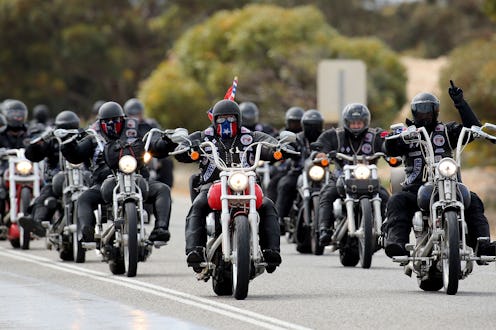News
What Do Motorcycle Gangs Want, Exactly?
While the FX drama Sons of Anarchy makes shootouts between biker gangs seem like old hat, last week's incident in Waco, Texas, was still jarring. Sunday's shootout between the outlaw motorcycle gangs Bandidos and Cossacks, which left nine people dead and led to 170 people getting arrested, was the deadliest singular event between rival bike gangs in history. At least five motorcycle clubs were present. But why? What are the larger implications and what do motorcycle gangs want exactly?
According to Edward Winterhalder, a former member of the Bandidos' Oklahoma chapter and bike gang expert, the occasion that brought the Bandidos, the Cossacks, and the other bike gangs together was a Confederacy of Clubs meeting, which gathers members to talk business, suss out new groups, and socialize. Winterhalder told Vice that these CoC meetings are usually peaceful, but there was already tension ahead of Sunday's meeting that led to the eruption of violence.
Kansas police officer Steve Cook, who's worked undercover with bike gangs, told The Washington Post that, judging by the weapons the members had on hand, it might seem that the bikers showed up to the Twin Peaks looking for a fight. Why? Because the Cossacks were wearing a Texas bottom rocker (the bottom patch) and the Bandidos, the biggest club in Texas, deem themselves to be the only MC allowed to do that.
That might seem silly to an outsider, but for motorcycle club members, their patches carry serious significance and shed some light on what it is that bike gangs want. While Jax Teller, the protagonist on Sons of Anarchy, just wanted to give his family a secure life and get out of the outlaw lifestyle once and for all, it's not always that wholesome in real life. Here's what real-life motorcycle gangs often really want.
Territory
Just like with any gang, territory is crucial. It not only defines where the gang generally lives and operates, lending a sense of identity to the club, but it also determines where they can do business and therefore influence profitability. While for most of their history, MCs only worried about maintaining their own territories instead of strategizing to seize more, in the last 20 years they've started getting more expansionary.
MC expert James Quinn told Vox:
A couple of decades ago it would've been a real clear picture, with the Hells Angels in the West Coast and the Northeast, the Outlaws in a swath from Florida to Detroit and Chicago, the Bandidos from the Midwest down to Texas and up to Washington State, and the Mongols largely in Southern California. Since then, all of those clubs have been expanding, and they've been expanding into each other's territories.
This was precisely what the Cossacks were attempting to do in Texas, which prompted the Bandidos to stop them in their tracks.
Money
When is it ever not about money? It's no surprise that one of the main goals driving MCs to outlaw is making money. The FBI describes outlaw motorcycle gangs as "organizations whose members use their motorcycle clubs as conduits for criminal enterprises." These enterprises include drug, weapons, and human trafficking, prostitution, and extortion.
And we're not talking chump change. A Fortune article from 1992 reported that the major outlaw gangs like the Hell's Angels make up to $1 billion per year from their illegal businesses.
Power
There's no denying that the biker lifestyle has a certain lure, especially for those who seek power and respect. Once you're in a club, then the nature of that power changes. Clubs will often go to extreme lengths to maintain their position against rival gangs, including, naturally, murder. For example, when another gang encroaches on your territory or trafficking business, it's not unexpected for shootouts like the one in Waco to take place as a result.
Being an outlaw, by nature, comes with a feeling of invincibility, because you live outside the law. In Hunter S. Thompson's 1966 book, Hell's Angels: The Strange and Terrible Saga of the Outlaw Motorcycle Gangs, he quotes a magazine article about the Hell's Angels:
They call themselves Hell’s Angels. They ride, rape and raid like marauding cavalry — and they boast that no police force can break up their criminal motorcycle fraternity.
Camaraderie
Another aspect of the bike gang culture that attracts many men to join is a sense of loyal, almost unparalleled camaraderie. According to Quinn, the whole culture was initially built on this notion. He writes in a 2001 paper:
Thrill-seeking attracted some returning veterans to choose a saloon society lifestyle centered around motorcycles. Positive views of military experiences, and the intense camaraderie they bred, also made such a lifestyle attractive. In some cases, combat roles became master statuses for veterans who could not tolerate military discipline but linked their self-image to the small-group camaraderie and risk-taking of military service.
The same goes for the 99 percent, the law-abiding motorcycle clubs that make up the majority of this subculture. Bike gangs are kind of like fraternities for older men.
To Ride
At the heart of every MC is a pure passion for motorcycle riding. According to the American Motorcyclist Association's website, AMA members ride an estimated 1.55 billion miles per year. That is a lot of riding. As for the outlaw clubs, a Hell's Angels member will ride, on average, more than 20,000 miles a year in any conditions.
Images: Getty Images (6)
